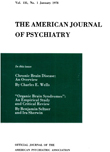A CONTROLLED STUDY OF DIAZEPAM IN PSYCHIATRIC OUTPATIENTS
Abstract
A series of 103 patients with psychoneurotic or psychotic disorders, most of whom had been under treatment for a long period, were given diazepam (Valium) for periods ranging up to a year. The usual dosage was 5 mg. t.i.d. but the daily intake was adapted to each patient in a range of 6 to 50 mg./day, taken in 3 to 8 doses. In a few cases of severe depression isocarboxazid was used adjunctively.
Results of diazepam therapy were judged good or excellent in 98 patients (95%). The agent was especially potent in relieving anxiety-tension, panic and depression, and raised the emotional tone of patients, enabling them to think more clearly and to relate better to other people and to their work.
Of the series 60 were switched to identical placebo medication on a blind basis. Half of them, after a month on placebo, became definitely worse in all symptoms, 21 showed no change, and 9 maintained gains previously made under the active drug. The psychotic patients regressed more rapidly under placebo than those with psychoneurotic reactions.
In the author's experience, the percentage of improvement under diazepam, and the recurrence of symptoms on placebo are noteworthy. It is the best drug he has ever used in alleviating anxiety, and especially depressions in the older individuals. Of other controlled studies(9-11) that of Vilkin and Lomas, of 95 hospitalized and private patients, agrees most closely with the author's in the following observations:
1. Dosage of 5 mg. t.i.d. appears to be the most acceptable intake, and at this level patients become tranquil but mentally alert.
2. Patients in the difficult years between 40 and 60 do extremely well on diazepam, rapidly experiencing relief from anxiety, depression, phobias and inability to function well in work or personal relations.
3. Diazepam exerts a desirable degree of stimulation in helping the overwhelmed patient to regain confidence in himself, so that he or she can return to work or to household duties which had seemed too difficult to cope with.
4. Habituation to sedatives and analgesics may be corrected in some patients and in others a reduction of intake is possible. Patients scheduled for EST may in some cases achieve a remission on diazepam alone.
5. When patients who have been improving on diazepam are switched to placebo their symptoms are apt to return.
The author feels that the use of adjunctive drugs with diazepam should be further studied. In the present investigation, insomnia, a chronic symptom in most of the patients, was apt to persist, albeit in a milder form, when diazepam was the sole medication. The addition of a sleeping pill was indicated in stubborn cases. A second possibility is the concomitant use of isocarboxazid (Marplan) in severe depressions. Pignataro(12) reports marked success with this procedure, and the author's experience of combined therapy in a few cases was similarly satisfactory. Diazepam appears to combine well with the medications used in this study, and its lack of toxicity should make exploration of this field fruitful.
Access content
To read the fulltext, please use one of the options below to sign in or purchase access.- Personal login
- Institutional Login
- Sign in via OpenAthens
- Register for access
-
Please login/register if you wish to pair your device and check access availability.
Not a subscriber?
PsychiatryOnline subscription options offer access to the DSM-5 library, books, journals, CME, and patient resources. This all-in-one virtual library provides psychiatrists and mental health professionals with key resources for diagnosis, treatment, research, and professional development.
Need more help? PsychiatryOnline Customer Service may be reached by emailing [email protected] or by calling 800-368-5777 (in the U.S.) or 703-907-7322 (outside the U.S.).



